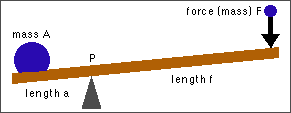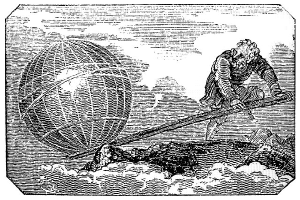

A lever is a plank, rod or other straight implement supported at one point. The law of the lever gives the condition under which two loads are balanced; this also gives the minimum force F required to lift a mass A.
If the distance from the mass A to the support point P (called the fulcrum) is a and the distance from the fulcrum P to the mass F is f, the lever is balanced if
A a = F f
This Law of the Lever allows the determination of the minimum mass required to push the lever down at the right to lift the mass A on the left. Example: A 4 year old child weighs 15 kg and has a plank of 6 m length. Where does the plank have to be supported so that the child can lift 75 kg? Answer: At 1 m from one end:
Placing it closer to the 75 kg mass will of course make the job even easier.
Pappus of Alexandria reports in his "Collection" (Synagoge, Book VIII, c. AD 340 [ed. Hultsch, Berlin 1878, p. 1060]) that after having discovered the Law of the Lever Archimedes made the remark: "Dos Moi Pou Stw kai Kinw thn Gen" (Give me a place to stand on and I will move the Earth.). The engraving below, from the Mechanics Magazine published in London in 1824, illustrated this undertaking.
